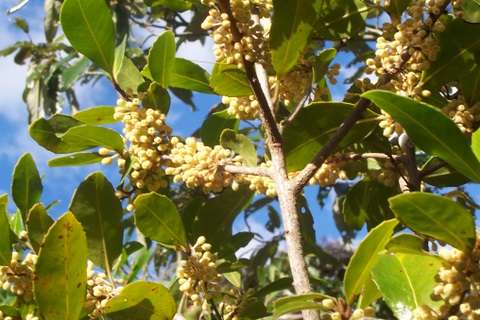Rapanea variabilis
Rapanea variabilis, known as the muttonwood or variable muttonwood is a tree of eastern Australia. The range of natural distribution is from near Milton (35° S) in southern New South Wales to the McIlwraith Range in far north Queensland (13° S).
| Rapanea variabilis | |
|---|---|
.jpg) | |
| Scientific classification | |
| Kingdom: | |
| (unranked): | |
| (unranked): | |
| (unranked): | |
| Order: | |
| Family: | |
| Genus: | |
| Species: | R. variabilis |
| Binomial name | |
| Rapanea variabilis (R. Br.) Mez | |
| Synonyms[1] | |
| |
The habitat of the muttonwood is at the edges of rainforests of various types; including tropical, sub-tropical, warm temperate and littoral rainforest.
Description
A small tree to around 15 metres tall and up to 50 cm in stem diameter. Noticeable for the dense, dark foliage and attractive blue fruit.
The trunk is straight and mostly cylindrical. The base of the tree is not buttressed. Bark is grey or brown, somewhat corky and rough with various irregularities; such as horizontal lines and vertical cracks.
Leaves are practically sessile, the leaf stalks less than 5 mm long. Leaves alternate, toothed on young plants, wavy edged and relatively stiff. Reverse lanceolate to oblong or egg shaped; 3 to 8 cm long, not usually with a tip at the point. Leaf veins are raised and noticeable on both surfaces.
Cream flowers form in clusters along the ends of branches. 2 mm long flowers on 4 mm long flower stalks, the flowering period is mostly around July to August. The blue or violet coloured fruit mature between November and December; being a 4 to 6 mm diameter drupe.[2]
The fruit is eaten by Lewin's honeyeater and the rose crowned fruit dove.[2] Germination from fresh seed occurs without difficulty. Removal of the fleshy aril is recommended to assist seed germination.

References
- "The Plant List: A Working List of All Plant Species". Retrieved 29 January 2014.
- Benson, Doug; McDougall, Lyn (1997). "Ecology of Sydney Plant Species Part 5: Dicotyledon Families Flacourtiaceae to Myrsinaceae" (PDF). Cunninghamia. 5 (2): 330–544.
- Floyd, A. G. (1989). Rainforest Trees of Mainland South-eastern Australia (1st ed.). Port Melbourne: Elsevier Australia - Inkata Imprint, copyright Forestry Commission of New South Wales (published 1989-12-01). p. 236. ISBN 0-909605-57-2. Retrieved 2009-06-13. (other publication details, included in citation)
- "Myrsine variabilis". PlantNET - NSW Flora Online. Retrieved 2009-06-13.
| Wikimedia Commons has media related to Myrsine variabilis. |